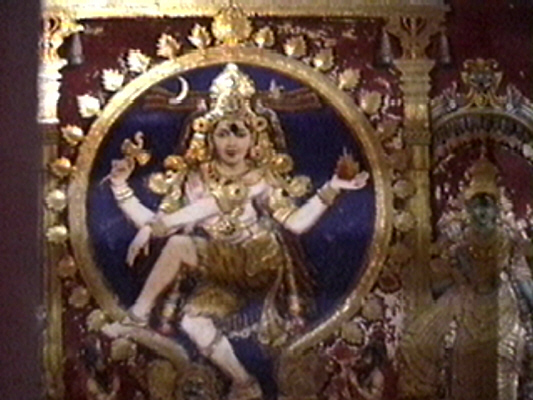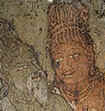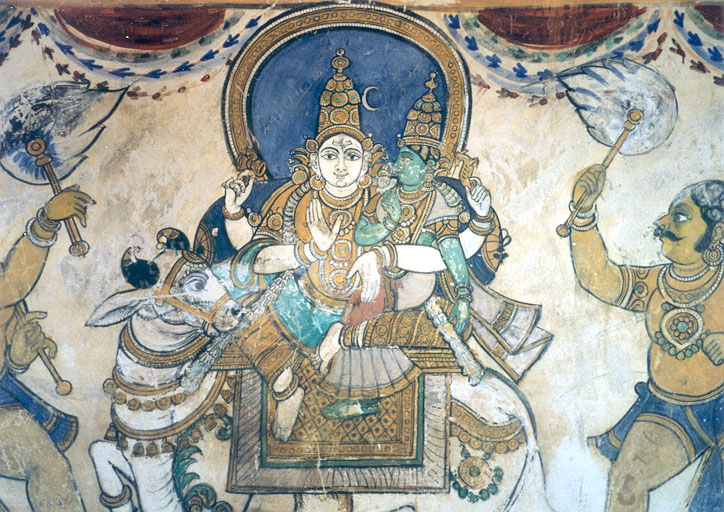Abodes of Ganesha
Temples of Tamilnadu
|

Temple Murals
Indian temples have not only been centers of worship, but have also been venues for expression of the creativity of the human spirit using a range of media. Thus, temple culture has promoted art in a variety of shapes and forms. Examples include and are not restricted to music and dance, architecture, sculpture, woodwork and paintings. Paintings form the focus of this brief feature on Templenet.
The dictionary meaning of the word mural is a very large image applied directly to a wall or a ceiling. Indeed, ornate murals are seen several temples all over India as a part of the complex tapestry of decorative work that have evolved through the ages. It may be a little known fact that one of the largest murals ever painted in Asia happens to be on the ceiling of the shrine at the Veerabhadreswara temple at Lepakshi in Andhra Pradesh in South India.
The phrase Indian murals, immediately brings the Ajanta paintings to one's mind. The Ajanta paintings date back to the earlier part of the 1st millennium CE and are primarily Buddhist in religious affiliation. These murals painted with vegetable and mineral dyes in caves were discovered in early 19th century. The murals at Ajanta represent the Buddha as well as instances from the Jataka tales. The Ajanta and Ellora caves form part of well visited tourist circuits in the state of Maharashtra.
The 6th century Chalukyan rulers of South India also used painting as a medium in expressing their creativity, as seen in the murals of Badami in Karnataka depicting for instance the royal court of Indra the King of the Devas. Badami, also known as Vatapi was won over by the Pallavas later, and an image of Ganesha brought back to the Chola empire by Sirutonda Naayanaar is enshrined at Tiruchenkaattankudi in Tamilnadu.
Sittannavaasal near Pudukkottai (near Tiruchirappalli) in Tamilnadu has Jain murals from the Pandya period.
The Brihadeeswarar temple in Thanjavur which dates back to the 11th century CE has many murals within. The enclosure surrounding the sanctum here has brilliant works of art, both in terms of sculpture and painting. The ancient Chola murals once covered all the walls and ceilings of this enclosure. Later 17th century paintings of the Nayak period were added over them; however some of the older Chola murals have been restored. Seen in this enclosure around the sanctum is an image of the monarch Raja Raja Cholan who was primarily responsible for temple centered cultural growth shown with his preceptor Karuvoor Devar. . It is to be noted that this monarch renovated (and rebuilt with stone) several of the temples in the Chola kingdom that had been visited and praised by the Tamil Saints of the Bhakti movement of the 2nd half of the 1st millennium CE.
Mention must also be made of a mural (in this enclosure) that depicts grand cosmic dance of Nataraja at Chidambaram. Depicted in this mural are images of Rajaraja Chola and his queens. There is also a gigantic painting of Shiva as Tripurantaka, depicted on the northern wall of the enclosure.
A large circumambulatory passage (prakaram) surrounds the main temple. It is bounded by fortress like walls lined with a pillared cloister. At the back of this pillared cloister that lines the entire stretch of the walls, there are several cells filled with Shiva lingams, and on the walls are paintings belonging to a much later period.
The Vijayanagar rulers were amongst the greatest of temple builders. Lepakshi in Andhra Pradesh houses the Virabhadreswara Swami temple. This temple is known for its exquisite carvings in the unfinished Kalyana Mandapam as well as for its collossal Nandi and its elegant murals which depict the various manifestations of Shiva. The murals here are full of vitality. Mention must be made of depictions of Kirataarjuneeyam, Dakshinamurthy and the divine wedding of Shiva and Parvati. The mukhamandapa has an 50 feet long panel, which bears paintings narrating the legend of Manu needhi Cholan (also portrayed in Tiruvarur which incidentally also houses murals depicting the legend of Mucukunda Chakravarti). The mukhamandapam also bears paintings depicting Krishna as a child, and scenes from the Mahabharata illustrating Draupadi's wedding.
The ardhamandapam of the Lepakshi temple bears paintings of 14 of the manifestations of Shiva (Dakshinamurti, Chandesa Anugraha murthy, Bhikshatana, Harihara, Ardhanareeswara, Kalyanasundara, Tripurantaka, Nataraja, Gowriprasadaka, Lingodbhava, Andakaasurasamhaara etc.)
The sanctum's ceiling bears a large painting which is said to be Asia's largest mural. This large painting of Veerabhadra measures about 23 feet by 13 feet.
Elsewhere in the Lepakshi temple are paintings depicting the incarnations of Vishnu. The Lepakshi temple is an unfinished temple (in part), but is a perfect synthesis of architecture, sculpture and painting.
The Vijayanagar ruler's patronage extended deep into Tamilnadu and the brilliant murals in the Srirangam temple are yet another feature in the never ending display of art treasures in a vast temple complex that is also a repository of ancient worship traditions. In the innermost circumambulatory passage in the Srirangam temple are 300 year old paintings depicting scenes from the epics.
The Nayak and the Maratha period of the mid and later 2nd millennium CE also saw a flourising of art. Seen in the Brihadeeswarar temple are more recent murals were painted over the more ancient Chola paintings.
Many of the temples of Kerala boast of grand murals all around the sanctum in the innermost enclosure. Mention must be made of paintings in the Ananta Padmanabhaswamy temple in Tiruvanandapuram and the Ettumanur Mahadevar temple at Ettumanur.
One of the best displays of murals is the Chitrasabha or the hall of pictures. As the name Chitrasabha suggests, the very structure is a house of paintings. The Chitrasabha is a stand alone structure, that is located a few blocks away from the Kutralanathar temple at Kutralam in southern Tamilnadu. It is a wooden structure , every inch of whose walls are lined with murals depicting scenes from the epics. From the outside, the Chitrasabha resembles mandapams seen in Keralite temples. The Chitrasabha or the hall of pictures is used for worship only during Margazhi Tiruvadirai where an image of Nataraja is brought into the sabha. Chitrasabha is considered to be one of the 5 sabhas, or the Cosmic Dance Halls of Shiva Nataraja in the southern state of Tamilnadu.


